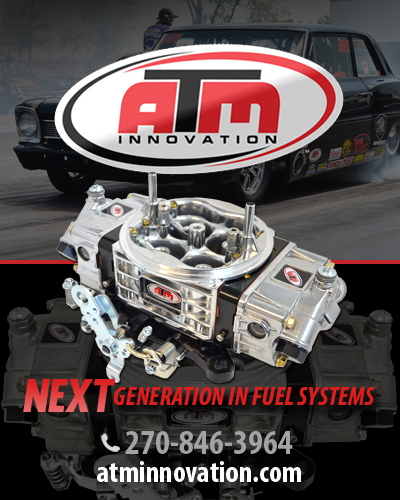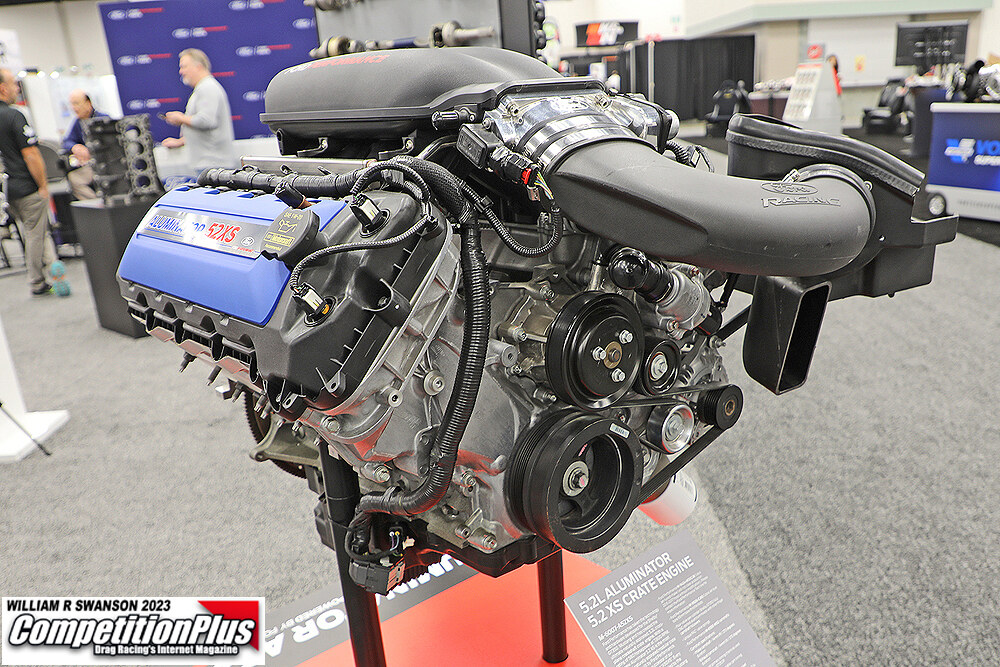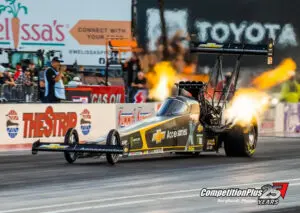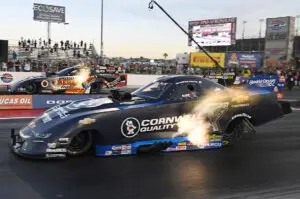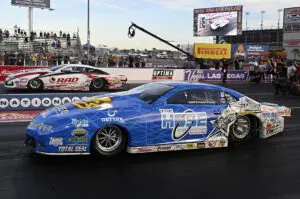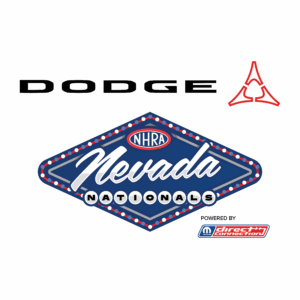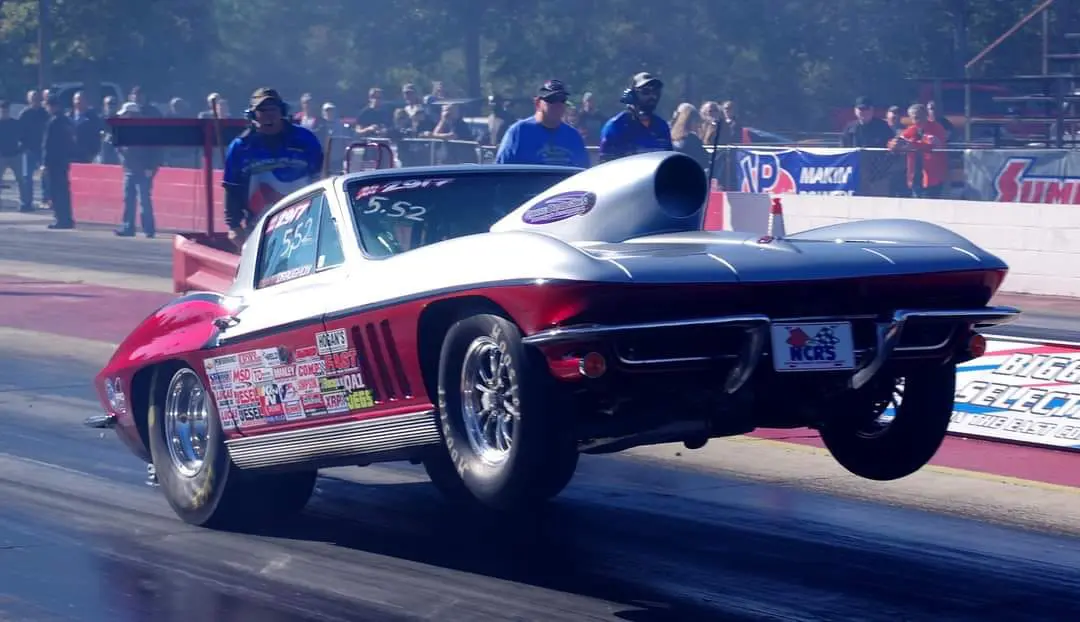The purpose of this series is to bring a fuller understanding of the
major components of Top Fuel Dragsters and Funny Cars with an  insider’s
insider’s
perspective. We will touch on many items in detail and how the
components and various systems are interrelated along with a few side
notes and an occasional story along the way.
The list of subjects covered will be vast and detailed to the degree
necessary for the above average fan and simple enough for the average
fan to come away with a better appreciation of the intricacies of the
modern “Nitro” car.
Today’s lesson focuses on the dragster body and aerodynamics.
This Special Series Gives You The Insides and Outs of Nitro Racing from the Technical Side …
Mike Kloeber is certainly one of the most talented tuners to ever crew chief a nitro car.

He began working in the nitro ranks during his teenage years, spinning the wrenches for champions such as Gary Beck, Jeb Allen and the Candies-Hughes team, just to name a few.
Kloeber earned his first crew chief job in 1986 when the legendary Don “Snake” Prudhomme hired him away from Tom “Mongoose” McEwen.
He took a break from racing in 1990 to pursue an education in aeronautical engineering and was content to pursue a job in another field until he assisted Len Seroka in returning to Top Fuel.
The sport might have been on the sidelines for Kloeber, but a few trips to the track provided all the proof that he needed to confirm the passion still burned in his heart for drag racing.
Kloeber joined on with Jim Epler and tuned his Funny Car to the sport’s first 300-mph Funny Car run.
Of all the accolades he gained along the way, few could compare with the six IHRA Top Fuel world championships he earned alongside of Clay Millican, a driver with whom he tuned from his first ride in 1999 up until 2007.
He’s since enjoyed stints with Bob Tasca III and Kenny Bernstein Racing.
Kloeber accepts his latest drag racing role, an opportunity which provides the challenge of educating the above average drag racing fan with the intricacy involved in maintaining and tuning a Top Fuel dragster.
UNIVERSITY SYLLABUS
The purpose of this series is to bring a fuller understanding of the major components of Top Fuel Dragsters and Funny Cars with an insider’s perspective. We will touch on many items in detail and how the components and various systems are interrelated along with a few side notes and an occasional story along the way.
The list of subjects covered will be vast and detailed to the degree necessary for the above average fan and simple enough for the average fan to come away with a better appreciation of the intricacies of the modern “Nitro” car.
a d v e r t i s e m e n t
Click to visit our sponsor’s website
GETTING STARTED – THE DRAGSTER BODY AND AERODYNAMICS 101
In this section we will cover the body and its function as well as its part in the performance of the vehicle. I have spent a considerable amount of time researching and testing this area of the race car. For practical purposes aerodynamics of aircraft is simpler to study and understand. This is because air is moving around the craft freely. A race car operates on the track which complicates the issue due to ground effect. I will give you some basics on this very complicated subject including some terminology and how various aspects of aerodynamics come into play.
UNDERSTANDING THE DRAGSTER BODY

Cowl and high windshield
Dragster bodies are typically made from .035 and or .040 magnesium. Generally it takes two sheets of magnesium to bend up a body. The upper cowl section the windshield is fastened to is typically a composite part. The windshield height and shape is an area of debate. Some consider the windshield to be both protective and an aero device to steer the air stream to the injector. A few years ago Tony Schumacher had a broken blower belt hit his tall windshield and he thought if he had a more open cockpit, like Brandon Bernstein or Clay Millican use, he possibly could have been hurt. Getting whacked by a blower belt is rare for Tony because that would mean he was behind and that hasn’t happened very often in the last five years. To think there is any significant benefit to the windshield height or placement is poop.
The general rounded shape and location of the windshield doesn’t lend itself to creating a downstream vortex that would steer air into the inlet. That vortex would need to be created further forward, than at the base of the wind shield, to be an advantage.
The injector primarily benefits from being up high and above the turbulent air flow over and around the roll cage. In reality you have to have a little something there to steer the air away from the driver’s helmet so his head doesn’t get buffeted around or get hit by a bug. I saw Richard Tharp almost crash when a giant bug hit him in the visor at Columbus one year in the Candies and Hughes dragster. He said it scared the crap out of him, the splatter covered a third of

Low windshield
his visor. I thought he was joking (you could never tell with Richard he was quite a character) until I saw his helmet.
I prefer the taller bodies with little or no windshield. The increased angle of the body helps to make a small amount of front downforce without increasing the frontal area and that would allow you to take a small amount of front wing out which should be measurable in terms of a reduction of induced drag. Styling vs. aero is usually a war between what works best and what looks good.
Gary Eaker, an aero guru formerly with GM, he did a stint at Hendricks Motorsports, who now has his own wind tunnel specializing in NASCAR development, has a saying “if it looks aerodynamic it probably isn’t.”
The body itself doesn’t play a large role in the total aero package. Making the body taller or wider like the body Brad Hadman did for Joe Amato is exciting and keeps things from getting uninteresting. The rear wing dominates the aero package.
The use of the one piece composite body has fallen out of favor with many of the teams. There is a small weight penalty because it weighs just a little more. I feel that the extra weight is offset by having a light driver and the increased minimum weight. Unfortunately, the additional weight is weight is in the wrong place; at the nose and that is a critical tool in adjusting the car from track to track and at times, from run to run. You will see Alan Johnson changing the nose weight in the staging lanes depending on how he thinks the track is. The little stuff can really make a difference.
We could get that extra weight out with a different layup schedule and different coring. A few also think the one piece body lets the chassis arch up differently than when the mag body is used. The mag body is fastened only to the bottom frame rail and to each other with overlapping panels fastened securely at one end. The other end of the panel is held in place by the overlapping. We ran several 4.40’s with Clay’s car so I don’t really think the mag body is better. The main reason we did the one-piece body is we got tired of having body panels fly off and get run over. How safe can that be? Not to mention mag costs $1000.00 a sheet when you can get it. It’s also very strong and durable. The body Clay is running has several seasons on it. It’s strong enough for his crew chief Lance Larsen to stand on it and he isn’t a little guy. Actually, Clay and I both stood on it once and it didn’t budge. The composite body is worth the extra money not to mention that vinyl applies to it easier.
a d v e r t i s e m e n t
Click to visit our sponsor’s website
THE DRAGSTER BODY AND AERODYNAMICS 102 – THE FRONT WINGS
Front wings are constructed very similar to the rear wing with the mounting points at the center to facilitate the nose mounting method typically used today. The single front wing has also replaced the two piece wing used in the past. In order to keep the front wings from getting larger to counter balance the effect of the rear wing and engine torque Mike Magiera made the wing more efficient with more downforce at the same time. When I made the switch from a two-piece front wing to the single front wing It seemed as though we picked up something like 2 to 4 MPH. This would be mostly attributed to the reduction in drag. At the same time the car seemed to handle a little better as well.
The latest addition to the front wing is an extension of the chord length with a “Gurney flap” extension employing the use of a saw tooth shape in the center of the Gurney flap. The saw tooth shape is also known as crenellating. This modification creates more down force and allows the angle of attack to be decreased. The other part of the front wing update is newly shaped end boards or spill plates. These new parts increase the efficiency of the front wing and also help the down force. (L/D)
THE DRAGSTER BODY AND AERODYNAMICS 103 – THE KICK-OUTS
The Kick-outs add downforce forward of the center of pressure and punch a hole in the air for the rear tires to some degree. Kick-outs initially were intended to decrease dependency on the rear wing. If you take them off, the car will still go down the track but they do help. Canard wings work much better, but are no longer allowed. Located on the sides behind the driver the kick-outs play a small role in the aero package. I have a new design for the Kick-out that we are going to work on at Stohr Cars west in Portland, OR after they finish their current Formula Atlantic project. They are still Kick-outs just a little different shape and if you ask me the current dragster could stand a little styling change.
THE DRAGSTER BODY AND AERODYNAMICS 104 – GURNEY FLAP OR WICKERBILL
This aerodynamic appendage was first used by Dan Gurney and is most often a simple length of aluminum or carbon fiber material placed at the trailing edge of a wing at a right angle. In the U.S., we call them Gurney flaps and in Europe they are commonly referred to as a Wickerbill. The Gurney flap reduces flow separation on the lower side of the wing particularly in high angle of attack applications.

The above drawings demonstrate the flow around the trailing edge of a Gurney flap. –
© Drawing by Paul Haney Inside Racing Technology
a d v e r t i s e m e n t
Click to visit our sponsor’s website
THE DRAGSTER BODY AND AERODYNAMICS 105 – BELLY PANS
Belly pans are another much-maligned subject. From a functional stand point they serve two purposes. First they catch the stuff that comes out of the engine that isn’t supposed to come out and the other is that they lower drag and slightly improve downforce. Most people don’t like them because they are part of a larger problem of weight and they have to come on and off after every run. Past experience tells us that weight is king, lighter is better. As time goes on the cars continue to get heavier and as a result more difficult to accelerate.
Newton’s second law says. (F=m*a) Currently many of the dragsters have a weight bar to make the minimum weight. This allows a little freedom for aero devices like belly pans and other components that will make the car perform better.
This leads me to… what is CFD?
CFD stands for Computational Fluid Dynamics. Basically it’s an enormous and complex math problem solved by computers. The human interface is still required to input the correct information. Other than that you just wait. Just kidding… all my aero friends will kill me for saying that.
CFD allows testing of a large number of variables without modifying existing components. Predicting performance through CFD minimizes the risks inherent in design changes. For many, the visualization capabilities are very compelling and help to breed innovation and validation. CFD has a wide range of applications, weather science, civil engineering, electronics-semiconductor, health care, athletics, acoustics etc.
With the rapid changes in CFD capabilities I predict that in 10 years time many wind tunnels will become office space. I’m going to get killed for that one too.
a d v e r t i s e m e n t
Click to visit our sponsor’s website
THE DRAGSTER BODY AND AERODYNAMICS 106 – MONO-STRUT AND CFD

Standard wing configuration vs. Mono-strut – Pressure distribution of the standard configuration.
I’ll bet you thought I would never get to this subject – the Mono-strut.
Don Garlits showed it was better. His back half numbers (the E.T. from the eighth-mile to the finish line) were consistently better that

Here is what the Mono-strut wing stand looks like before the skin is on, and how it ran first on Fuller’s car.
the other dragsters when he ran a mono-strut. If you want to see Garlits get excited, ask him why nobody runs one. I was able to verify that the Mono-strut was better through a very comprehensive CFD aero study with the help of John Moloney at the Penske Technology Group and what now is TotalSIM.
The entire car was scanned at Penske’s (PTG) in Mooresville, NC. PTG did the wire mesh model and sent that to England where PhD Jo Scott and Rob Lewis oversaw the project. The results of the aero study told us the total downforce is calculated to be in excess of 11,000 lbs. including the exhaust forces. That would be the front and rear wings plus the force of the exhaust. Of course I’m not going to just blurt all the information out in this forum. Suffice it to say, we gained an incredible amount of information from the study and nobody except myself, the people at PTG and Advantage have seen all the data we collected over a two year time frame.
Two years ago, Rod Fuller ran a 4.49 with the Mono-strut wing and shut off early. That would have arguably been sub 4.47 in Phoenix pre-season testing with the Mono-strut without any tail skin on it. When they ran it with the tail skins on, during testing after the Gainesville NHRA event, some handling problems were encountered and the team elected to put the project on the back burner and it was never tried again.
I suspect that there were some attachment and shape issues with the tail skins. Another factor in the initial disappointment was the lack of all the CFD aero study information. The tail skin needed to be made a little closer to the intended shape that was tested among other things. It is entirely possible that the wing stand may not even need to be skinned.
I look forward to the day when I can contribute to finishing the project, for which the Werner Enterprises people have already provided considerable funding. Done properly, the package will be of value to all the teams.
With the performance of the cars getting closer, small gains will become more significant in the outcome of qualifying and eliminations. The people who are better at adjusting the aero package to complement the engine and clutch setup will triumph as winners.
The Mono-strut design is simply one of those “It works” components. I won’t bog you down with all the details of the aero study. A major part of CFD work is to study the downstream vortex. This is the practice of entraining the air flow in critical areas to direct the air flow where it can be best utilized.

The oil flow modeling shows the basic improvement in the rear wing performance by moving the mounting point to a central location. Covering the exposed wing stand creates a little less drag along with a correcting force to help make the car more stable.
Some of the other areas of the research were – finding the center of pressure, the use of belly pans and their effectiveness, underbody air flow, the force of the exhaust and its relationship to the performance of the rear wing, the use of side pods to reduce dependency on the rear wing alone and the creation of a crushable area next to the driver.
We were also able to simulate the increase or decrease in down force with atmospheric changes and angle of attack.
Another area of interest uncovered in the CFD study was the build-up of pressure under the body in front of the driver’s feet. Since the under body area is mostly open, air packs under the body and being at a higher pressure that air is trying to get out. Without enough vent area and securely fastened body panels they tend to get pushed outward and torn off the car like tissue paper. Most of these lost body panels aren’t lost directly due to a single aerodynamic phenomenon but more likely a series of events like; shake loosens up the Dzus fastener or wallows out the Dzus hole over time and the result is a body panel exiting the car; sometimes when there isn’t any shake at all. Regardless of the cause, losing a body panel is a serious issue.
a d v e r t i s e m e n t
Click to visit our sponsor’s website
THE DRAGSTER BODY AND AERODYNAMICS 107 – THE REAR WING

These are two different methods of releasing the pressure.

The construction of the rear wing is a very important element. To date we have not suffered from a catastrophic wing failure. And there are rear wings on the track that are over 10 years old. I would say that is a tribute to Mike Magiera, his expertise and ingenuity. He is often overlooked and under appreciated for his contribution to Top Fuel and the other winged dragster classes. He is constantly tweaking the design and construction. Magiera was also a valuable contributor to the Mono-strut project.
The triple element wings used on dragsters are constructed differently than the composite wings used in other motorsport disciplines. With the requirement of the mounting tabs needing to run through the skins to attach the wing to the chassis the strength of the wing relies on the skin itself to be the main structural component. Construction techniques are continually changing to meet the demands of the rear wing application. To date other manufactures have copied Magiera’s design shape (wing profile) and construction techniques. Basically the car is engineered around the wing. The rear wing is approximately 70% of the total aero package. I can make a case for the fact that the entire car is engineered around the rear wing. That’s why the bodywork is a drop in the bucket relative to the wings. With a multi element design the rear wing generates a monumental amount of downforce from a relatively small total area. With the upper flap at a very high angle of attack it is actually stalled until the air speed increases over its surface. The end boards help to tie the upper elements to the main wing as well as keep the air flow trapped and forced over the 3 elements. A new requirement from NHRA is for the rear wing to be dynamically tested on an annual basis. To do this test the main element is put in a load simulating press and tested.
THE DRAGSTER BODY AND AERODYNAMICS 108 – LIFT
We have covered some of the basics of the dragster body and its wings. This leads us to what makes lift? We can get really deep into things like Bernoulli’s principal, Venturi effect, the angle of incidence or angle of attack, and some other terms like Euler Equations and Navier-Stokes Equations, Reynolds numbers etc. Just for fun you can look up the last three terms, you should get a better understanding just how complicated aerodynamics can get. The best simple explanation of lift is to use what is called equal transit time. Think of lift as being created this way. When the relative wind (air) gets to the leading edge of the wing it must reach the trailing edge at the same time. With one side of the wing being longer than the other the speed of the air (fluid) is faster on one side. This creates a different pressure on one side of the wing vs. the other. On a race car this makes a downward ↓force and obviously for an airplane it makes upward force or ↑ lift. Even the explanation used above doesn’t cover all aspects of race car aerodynamics. Depending on what specific area you are working on most of the principal’s work in a combination. Aerodynamics can seem like the chicken or egg question.

Here’s a look at the very modest side pods we created. (This is the tame version.)
THE DRAGSTER BODY AND AERODYNAMICS 109 – TALKING THE TALK
You don’t have to be an expert in aerodynamics to be successful in Drag Racing. Buy a car from Hadman, McKinney or Ty Baumgartner. You can even build your own. Get your wings through your chassis builder who gets them from Mike Magiera or Ron Jones. Set the front wing according to you chassis builder and the rear according to the NHRA maximum of +2° and you are set. On a good aero day (cold or dense atmospheric conditions) take a little wing out and on a bad aero day (high temps and thin air) run the max. Some racers don’t ever change the wing settings.
The terms and definitions below are a general knowledge terms that come into play when a car uses wings and bodywork to create downforce. Some just by their proximity to the ground and others are more directly relative.
Lift, a mechanical force generated by a solid object moving through a fluid. (Air)
Drag, resistance to motion through the relative wind. Drag is a force which tends to reduce speed. (Wind resistance)
Induced drag, caused by the generation of lift by the wing and or the body. A side effect of creating lift is another explanation.
Drag coefficient, a quantity used in analyzing the amount of aerodynamic drag caused by fluid flow.
To calculate drag using air at standard conditions, V in mph, and drag in pounds of force, this equation becomes: Drag = 1/391 x Cd x A x V squared
The requirements to calculate drag are: Cd, the drag coefficient; A, the frontal area; and the speed V (Velocity). This equation shows an important point, aerodynamic forces are proportional to the square of the speed. In other words if you; Double the speed you quadruple the Lift – Double the speed you quadruple the Drag.
Lift-to-drag ratio, or L/D ratio, (this is expressed as L over D) is the amount of lift generated by a wing or vehicle, divided by the drag it creates by moving through the air. This one of the most often compared numbers associated with quantifying aerodynamics.
Frontal area; the surface area facing directly into the relative wind, it is typically measured in square feet or meters. This is needed to calculate Drag among other things.
Spoiler, an aerodynamic device whose intended function is to ‘spoil’ or create air movement across the body of a vehicle. The term Spoiler is often incorrectly and confused with, or even used interchangeably with, wings.
Bernoulli’s principle states that, an increase in the speed of the fluid (Air) occurs simultaneously with a decrease in pressure or a decrease in the fluids potential energy. In this case the energy would be lift or down force.

Venturi effect is the reduction in fluid pressure that results when a fluid flows through a constricted section of pipe. The fluid velocity must increase through the constriction to satisfy the equation of continuity, while its pressure must decrease due to conservation of energy: the gain in kinetic energy is balanced by a drop in pressure or a pressure gradient force.
Ground effect, (Air craft version) An aerodynamic effect due to flying in close proximity to the ground. When an airplane gets within the length of the wing span to the ground a cushioning begins to occur. As the plane gets closer to the ground gets cushioning effect increases.
Ground effects (race car version) This is basically using the underside of the body work (typically a smooth wing like shape) to accelerate the air through a channel creating a low pressure (down force). I like to think of this phenomenon as the communication of the air moving under the car with the body work and the ground. This is as close to a free lunch as you are going to get when you make down force.
Vortex, a stream of air swirling or spinning around a center. The speed and rotation is greatest near the center and decreases away from the center. Tornado comes to (mind)
Boundary layer is a thin layer of air (fluid) nearest the surface the air is passing over.
Laminar flow is when the air (fluid) travels smoothly in a regular path or smoothly, allowing the layers to stack on each other.
Turbulent flow is the opposite of laminar flow (duh). It is typical of the chaotic flow pattern following what was previously a laminar flow condition. It is a rapid variation of pressure and velocity changes.
Angle of Attack, The angle between the chord of the wing and the relative wind.
https://www.grc.nasa.gov/WWW/K-12/airplane/foil2.html
For a little fun play with wing shapes and angle of attack. The above link will put you right in the middle of the educational part of the NASA web site. You paid for it so use it. I do! You can get lost in space there too.
This is the end of the segment on Dragster bodies. We will get to the Funny body next. Hopefully I didn’t drone on like an annoying professor I once had. As usual email me your questions. I will either answer them or direct you where you can do some research on your own. That’s the best way to learn. It wouldn’t be any fun if I just gave you all the answers.
Acknowledgments;
John Moloney
PTG Penske Technology Group
NASA
Rob Lewis TotalSIM
Paul Haney Inside Racing Technology
Dan Gurney All American Racers











